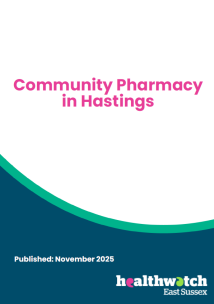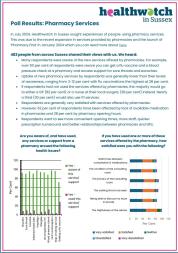Community Pharmacy in Hastings

What we did:
Over the last 18 months Healthwatch East Sussex (HWES) have heard through our outreach and engagement activities, our Information and Signposting Service and our recent Healthwatch in Sussex (HWiS) Pharmacy Poll about a range of issues and themes relating to local pharmacy provision.
In response, we devised a small-scale project to explore community pharmacy provision and user experiences across the ten pharmacies located in Hastings
What we found
Positive headlines:
- All the community pharmacy users we engaged with were able to receive the service(s) or products they were seeking on the day and gave generally positive feedback of previous experiences of using pharmacy services.
- None of the pharmacy users we engaged with during our visits felt they had encountered a barrier to accessing pharmacy services in the last 12 months.
- No pharmacy users we engaged with had chosen not to get a prescription due to the cost. The only issues identified by those we spoke to were waiting times and occasional unavailability of medications.
- Internal accessibility at all pharmacies was generally very good, with clear and easily navigable pathways from the entrance to the counter.
- All the pharmacy users (100%) we spoke to were either very satisfied or satisfied with the opening hours, feeling listened to and privacy. Almost all (88.9%) who had used a consulting room at the pharmacy were very satisfied with its condition.
Negative headlines:
- Some pharmacies lacked visible and clear signage to indicate if they offered Pharmacy First services, or what the service could provide i.e. the symptoms that could be treated and the eligibility criteria.
- Signage at pharmacies did not always make it clear what services the pharmacies offered, potentially making it difficult for people to know they offered Pharmacy First, health checks and other preventative schemes.
- User awareness of Pharmacy First was lower than anticipated, with only approximately half of those visiting pharmacies being aware of or having used these services.
- Most of the pharmacies we visited had heavy manual doors making it difficult for some people to access pharmacy premises, particularly those who are older or have mobility issues. Few had automatic doors or bells to summon assistance, and some had stepped access.
- Only one pharmacy had any information displayed explaining how the pharmacy could organise translation and interpretation services, and only one pharmacy had a hearing loop installed.
- There was no accessible information for people with diverse needs on display in the pharmacies, such as information available in different formats.
Recommendations
Based on our findings, we are recommending:
That individual community pharmacy providers:
- Provide clear and visible information or signage for customers and staff on how translation and interpretation services can be accessed for those who require BSL or alternative languages.
- Display clear and visible signage, both externally and internally, as to whether Pharmacy First can be accessed at their pharmacy, along with the 7 conditions which can be treated and the eligibility criteria.
- Ensure there is clear and comprehensive external signage indicating which services, including essential, advanced and locally commissioned, can be accessed at the pharmacy.
- Consider providing more information leaflets for service users where they can be easily accessed, such as an information wall or information stand, which includes Easy Read, large print and alternative language versions.
- Explore how to make the entrance to the premises more accessible. This could be the addition of an automatic door instead of manual, a ramp where there are steps, or a system by which service users can contact the staff team if they are struggling to enter, such as a bell or phone number.
- Consider installing a hearing loop for those who are hard of hearing, along with signage to indicate its presence and how to connect.
- Ensure that essential internal signage is well placed, well-lit and readable from customer facing areas, keeping in mind the diverse needs of different customers.
- Consider undertaking your own accessibility audit of the premises to reflect what measures could make the site more accessible and welcoming to all service users.
That pharmacy commissioners (NHS Sussex):
- Ensure all primary care services and their staff are aware of how to access translation and interpretation services (including BSL) for service users and their contractual obligations to do so.
- Consider providing community pharmacies with simple, clear and branded signage for Pharmacy First to aid promotion, including materials in accessible formats.
- Explore how to support community pharmacies with challenging premises to become more accessible to those with physical or sensory impairments and offer financial support to ensure they meet the national requirements.
That Healthwatch East Sussex:
- Consider further exploration of people’s access to and experience of community pharmacy services to ensure that their experiences and needs are fed back to providers and commissioners.
- Continue to monitor feedback from service users and share themes and trends with NHS commissioners, Healthwatch England and the Local Pharmacy Committee.
Tell Us Your Experiences
Please tell us your experiences of local health and care services via our Feedback Centre and let us know how this has been for you.
We want to hear if it has been good, bad or indifferent.
Help and support with Health and Care
If you need help or support related to health or care, then please contact our Information & Signposting Service via
0333 101 4007 or enquiries@healthwatcheastsussex.co.uk
